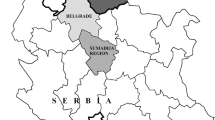Abstract
Selenium (Se) is an essential element, cofactor for glutathione peroxidase (GSHPx) activity, whose deficiency may induce modifications in the cellular antioxidative status and induce the appearance of different diseases. Current views suggest that a serum Se concentration inferior to 45 μg/L may correlate with an increased risk of coronary hearth diseases, coronary atherosclerosis and cancer.
Since the Se concentration in human blood varies between geographical areas, we initiated a study to evaluate the Se status in the general healthy population of Barcelona. Serum Se concentration was investigated in a random sample of 150 subjects (age range 18–70 yr) by graphite furnace atomic spectrometry (FLAAS). L'vov platform, Zeeman background correction, and other specifications of stabilized temperature platform furnace (STPF) concept were followed.
The results show that in the general population of Barcelona, Se serum concentration ranges between 60 and 106 μg/L (X=80.7±10 μg/L). These values can be considered within the safe limits, since no subject was found with a concentration lower than the threshold of 45 μg/L.
Similar content being viewed by others
References
L. Magos and M. Webb, The interactions of selenium with cadmium and mercury,Rev. Toxicol. Crit. 8, 1–42 (1980).
J. T. Rotruck, A. L. Pope, H. E. Canther, A. B. Swanson, D. G. Hafeman, and W. G. Hoekstra, Selenium: biochemical role as a component of glutathione peroxidase,Science 17, 588–590 (1973).
J. R. Arthur, F. Nicol, and J. Beckett, The role of selenium in thyroid hormone metabolism and effects of selenium deficiency on thyroid hormone and iodine metabolism,Biol. Trace Element Res. 33, 37–42 (1992).
B. A. Zachara, Mammalian selenoproteins,J. Trace Element Electrolytes Health Dis. 6, 137–151 (1992).
D. Behne, A. Kyriakopoulos, H. Meinhold, and J. Köhrle, Identification of type I iodothyronine 5′-deiodinase as a seleno-enzyme,Biochem. Biophys. Res. Commun. 173, 1143–1149 (1990).
G. Lockitch, Selenium: clinical significance and analytical concepts,Crit. Rev. Clin. Lab. Sci. 27, 483–541 (1983).
J. Nève, Physiological and nutritional importance of selenium,Experientia 47, 187–193 (1991).
O. Oster, W. Prellwith, Selenium and cardiovascular disease,Biol. Trace Element Res. 24, 91–103 (1990).
J. T. Salonen, G. Alftan, J. K. Huttunen, J. Pikkarainen, and P. Puska, Association between cardiovascular death and myocardial infarction and serum selenium in a matched-pair longitudinal study,Lancet 2, 175 (1982).
X. Chen, X. Chen, G. Yang, Z. Wen, J. Chen, and K. Ge, inSelenium in Biology and Medicine, J. E. Spallholz, J. L. Martin, and H. E. Ganther, eds., AVI, Westport, pp. 171–175 (1980).
Food and Nutrition Board, National Research Council. Recommended dietary allowances,Nutr. Rev. 38, 290–294 (1980).
A. T. Diplock, Indexes of selenium status in human populations,Am. J. Clin. Nutr. Suppl. 57, 256S-258S (1993).
M. F. Robinson, P. J. Godfrey, C. Thomson, H. M. Rea, and A. M. Van Rij, Blood selenium and glutathione peroxidase activity in normal subjects and in surgical patients with and without cancer in New Zealand,Am. J. Clin. Nutr. 32, 1477–1485 (1979).
X. Luo, H. Wei, C. Yang, J. Xing, C. Qiad, Y. Feng, J. Lieu, Z. Lieu, J. Wu, Y. Lieu, B. J. Stoecker, J. E. Spallholz, and S. P. Yang, Selenium intake and metabolic balance of 10 men from a low selenium area of China,Am. J. Clin. Nutr. 42, 31–37 (1985).
Z. J. Maksimovic, V. Djusic, M. Esumovic, Selenium deficiency in Yugoslavia,Biol. Trace Element Res. 33, 187–196 (1992).
F. J. Kok, A. M. de Bruijn, R. Vermeeren, A. H. Hofman, van Laar, M. de Bruin, R. J. J. Hermus, and H. A. Valkenburg, Serum selenium, vitamin antioxidants, and cardiovascular mortality: a 9-year follow-up study in the Netherlands,Am. J. Clin. Nutr. 45, 462–468 (1987).
T. J. Salonen, G. Alfthan, J. K. Huttunen, and P. Puska, Association between serum selenium and the risk of cancer,Am. J. Epidemiol. 120, 342–349 (1984).
J. Virtano, E. Valkeila, G. Alfthan, G. Punsar, J. K. Huttunen, and M. J. Karvonen, Serum selenium and the risk of coronary heart disease and stroke,Am. J. Epidemiol. 122, 176–282 (1985).
P. A. McAdam, D. K. Smith, E. B. Feldman, and C. Hames, Effect of age, sex and race on selenium status of healthy residents of Augusta, Georgia,Biol. Trace Element Res. 6, 3–9 (1984).
A. Brtková, T. Magálová, K. Babinská, and A. Béderová, Serum selenium levels in Slovak population,Biol. Trace Element Res. 46, 163–171 (1984).
I. Lombeck, K. Kasperek, H. D. Harbisch, L. R. Feinendegen, and H. J. Bremer, The selenium state of healthy children. I. Serum selenium concentration at different ages; selenium content of food of infants,Eur. J. Pediatr. 175, 81–88 (1977).
S. Hatano, Y. Nishi, and T. Usiu, Plasma selenium concentration in healthy children and adults determined by flameless atomic absorption spectrometry,J. Pediatr. Gastroenterol. Nutr. 3, 426–431 (1984).
W. Wasowicz and B. A. Zachara, Selenium concentrations in the blood and urine of healthy Polish sub-population,J. Clin. Chem. Clin. Biochem. 25, 409–412 (1987).
D. McMaster, N. Bell, P. Anderson, and A. H. G. Love, Automated measurement of two indicators of selenium status, and applicability to population studies,Clin. Chem. 36, 211–216 (1990).
G. Morisi, M. Patriarca, G. Marano, S. Giampaoli, and F. Taggi, Age and sex specific reference serum selenium levels and stimated for the Italian population,Ann. 1st. Super. sanita 25, 393–404 (1989).
A. Brtková, T. Magálová, K. Babinská, and A. Béderová, Serum selenium levels in Slovak population,Biol. Trace Element Res. 46, 163–171 (1984).
R. Van Cauwenberg, H. Robberecht, and H. Deelstra, Selenium concentration levels in whole blood of Belgian blood bank donors, as determined by direct graphite furnace atomic absorption spectrometry,J. Trace Element Electrolytes Health Dis. 4, 215–224 (1990).
Author information
Authors and Affiliations
Rights and permissions
About this article
Cite this article
Torra, M., Rodamilans, M., Montero, F. et al. Serum selenium concentration of a healthy northwest Spanish population. Biol Trace Elem Res 58, 127–133 (1997). https://doi.org/10.1007/BF02910673
Received:
Accepted:
Issue Date:
DOI: https://doi.org/10.1007/BF02910673




